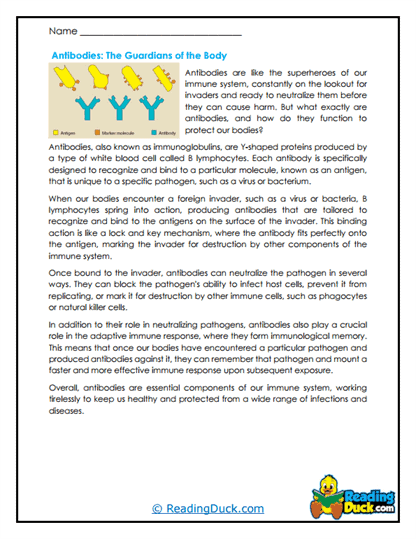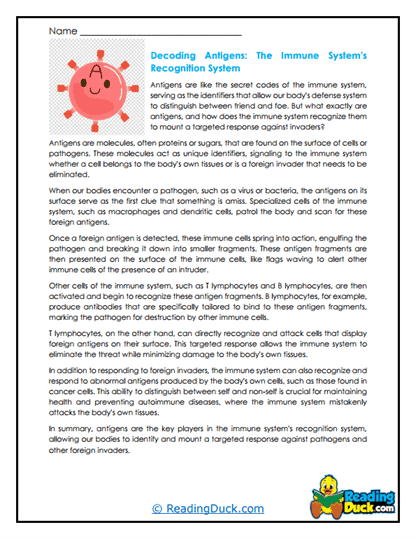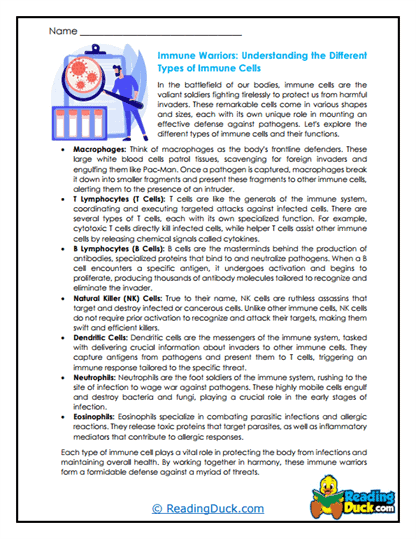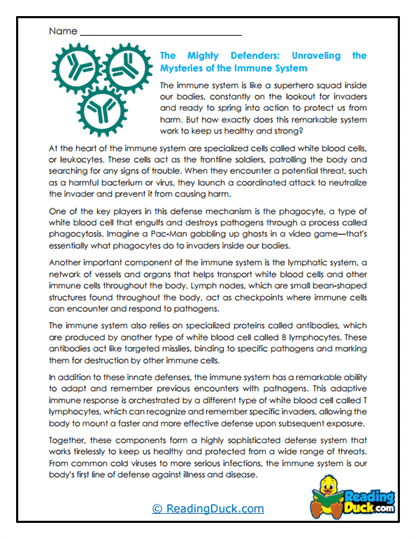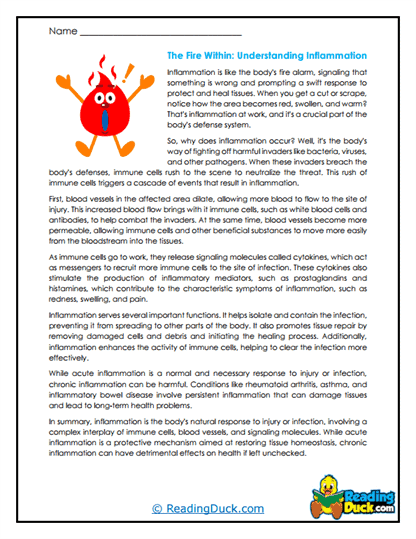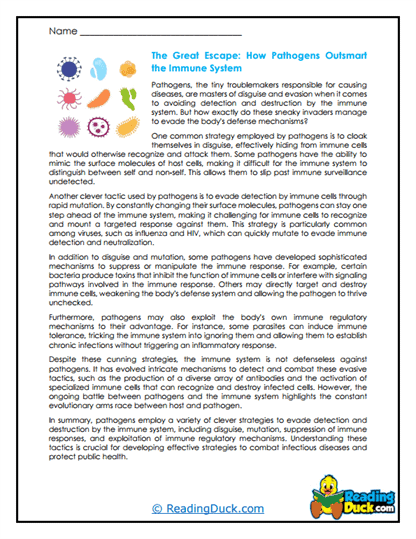Immunology Worksheets
About Our Immunology Worksheets
Our Immunology Worksheets offer an engaging exploration into the complex and fascinating world of the immune system, a crucial part of human biology that protects us from diseases and infections. As a subtopic under the broader categories of Biology and Microbiology, this collection provides students with a comprehensive understanding of how the immune system works, its components, and its vital role in maintaining health. Each worksheet set within this collection is designed to make learning about immunology both educational and interesting.
This collection contains several worksheet sets, each focusing on different aspects of immunology. Each worksheet set includes:
- Multiple Choice Questions: These questions assess students' comprehension of the reading material, ensuring they grasp the key concepts and details presented.
- Short Answer Questions: This section encourages students to articulate their understanding in their own words, reinforcing their knowledge and improving their ability to communicate scientific information effectively.
- Open-Ended Questions: These questions invite students to share their personal thoughts, opinions, and reflections on the material, fostering deeper engagement and critical thinking.
An answer key is provided for every question sheet, making it easy for educators and parents to review students' work. All worksheets are available in PDF format, allowing them to be easily viewed electronically, downloaded, and printed for use in various educational settings.
Understanding Immunology: Defending the Body from Within
Immunology is the study of the immune system, the body’s defense mechanism against infections, diseases, and foreign invaders. The immune system is incredibly complex, consisting of various organs, cells, and molecules that work together to detect and neutralize threats. When introducing students to immunology, it’s essential to cover the structure and function of the immune system, how it responds to pathogens, and the importance of vaccines and immune memory. Here’s a detailed breakdown of the key aspects of immunology covered in this collection:
Components of the Immune System: The immune system consists of several key components that work together to protect the body.
- White Blood Cells: Also known as leukocytes, these cells are the main players in the immune system. Students will learn about the different types of white blood cells, including macrophages, lymphocytes (T cells and B cells), and neutrophils, and their specific roles in defending the body against pathogens.
- Lymphatic System: The lymphatic system, including lymph nodes and vessels, plays a crucial role in transporting immune cells and filtering out harmful substances. Understanding the lymphatic system helps students appreciate how the immune system is distributed throughout the body.
- Antibodies and Antigens: Antibodies are proteins produced by B cells that specifically target antigens, which are substances recognized as foreign by the immune system. Students will explore how antibodies work to neutralize pathogens and how this process is critical for immune protection.
Immune Responses to Pathogens: The immune system responds to pathogens (such as bacteria, viruses, and fungi) in a highly coordinated manner.
- Innate Immunity: This is the body’s first line of defense, consisting of physical barriers (like skin), chemical barriers (like stomach acid), and immune cells that respond quickly to invaders. Students will learn how innate immunity provides immediate protection against a wide range of pathogens.
- Adaptive Immunity: Unlike innate immunity, adaptive immunity is highly specific and involves the activation of lymphocytes that “remember” past infections. Students will explore how adaptive immunity develops over time and how vaccines take advantage of this system to provide long-term protection against diseases.
- Inflammation: Inflammation is a key aspect of the immune response, characterized by redness, heat, swelling, and pain at the site of infection. Understanding inflammation helps students grasp how the body fights off infections and begins the healing process.
Vaccination and Immune Memory: Vaccines are one of the most effective tools in preventing infectious diseases.
- How Vaccines Work: Vaccines stimulate the immune system to produce a response similar to that of a natural infection, without causing the disease. This helps the body develop immunity to the pathogen. Students will learn about the different types of vaccines (such as live-attenuated, inactivated, and mRNA vaccines) and how they contribute to public health.
- Herd Immunity: When a large portion of a population is vaccinated, it helps protect those who cannot be vaccinated, such as individuals with certain medical conditions. This concept, known as herd immunity, is crucial for controlling the spread of contagious diseases.
- Immune Memory: The immune system has the remarkable ability to “remember” previous encounters with pathogens, allowing it to respond more quickly and effectively upon re-exposure. Students will explore how immune memory is the basis for the long-lasting protection provided by vaccines.
Autoimmune Diseases and Allergies: Sometimes, the immune system can malfunction, leading to autoimmune diseases or allergies.
- Autoimmune Diseases: In autoimmune diseases, the immune system mistakenly attacks the body’s own cells and tissues. Examples include type 1 diabetes, rheumatoid arthritis, and lupus. Students will learn about the causes of autoimmune diseases and the challenges in treating them.
- Allergies: Allergies occur when the immune system overreacts to harmless substances, such as pollen, pet dander, or certain foods. Understanding allergies helps students appreciate the complexity of the immune system and the fine balance it must maintain to protect the body without causing harm.
The Role of Immunology in Modern Medicine: Immunology is at the forefront of many medical advancements and treatments.
- Immunotherapy: Immunotherapy is a type of treatment that boosts or manipulates the immune system to fight diseases, particularly cancer. Students will explore how immunotherapy is used to target cancer cells, making it one of the most promising areas of medical research.
- Transplantation and Immunosuppression: In organ transplantation, the immune system may recognize the transplanted organ as foreign and attack it. Understanding how immunosuppressive drugs are used to prevent this rejection helps students grasp the challenges of organ transplantation and the role of the immune system in this process.
By studying these aspects of immunology, students gain a comprehensive understanding of how the immune system functions, its importance in protecting the body, and the challenges associated with immune-related diseases. The worksheets help break down complex concepts into engaging and accessible material, fostering curiosity and a deeper appreciation for the immune system's role in health and disease.
How to Supplement These Worksheets
Here are four creative ideas on how teachers and parents can use these Immunology Worksheets in school or in a homeschool setup:
- Immune System Role-Play Game: Organize a classroom activity where students role-play as different components of the immune system, such as T cells, B cells, and pathogens. Using the worksheets as a guide, students can simulate an immune response to an infection, demonstrating how the immune system detects and eliminates pathogens. This interactive activity makes learning about immunology fun and memorable.
- Create an Immune System Model: Encourage students to create a 3D model of the immune system, highlighting key organs and cells. They can use materials like clay, paper, and markers to build the model and label the different parts. This hands-on project reinforces the structural and functional aspects of the immune system and helps students visualize how the system operates.
- Research Project on Vaccines: Assign students to research the development and impact of a specific vaccine, such as the polio vaccine or the COVID-19 vaccine. They can use the worksheets to organize their research and present their findings to the class. This project emphasizes the importance of vaccines in public health and allows students to explore the science behind vaccination.
- Case Study on Autoimmune Diseases: Have students investigate a particular autoimmune disease, such as type 1 diabetes or multiple sclerosis. Using the worksheets, students can learn about the symptoms, causes, and treatments of the disease and discuss the challenges faced by individuals living with autoimmune conditions. This activity fosters empathy and understanding of chronic illnesses related to the immune system.
The Importance of Learning About Immunology
Understanding immunology is crucial for students on both an academic and personal level. Academically, it provides a foundation for advanced studies in biology, medicine, and public health. It also enhances critical thinking skills as students explore the complexities of the immune system, the mechanisms behind diseases, and the development of treatments and vaccines.
On a personal level, knowledge of immunology empowers students to make informed decisions about their health and the health of others. Understanding how the immune system works, the importance of vaccination, and the risks associated with autoimmune diseases and allergies helps students take an active role in their own well-being. This awareness can lead to healthier lifestyle choices and a better understanding of how to protect themselves and their communities from infectious diseases.
Overall, these Immunology Worksheets offer a valuable resource for educators and students alike, providing a detailed and engaging exploration of one of the most critical systems in the human body. Through these activities, students can deepen their understanding of immunology and develop a greater appreciation for the immune system's role in protecting and maintaining health.

